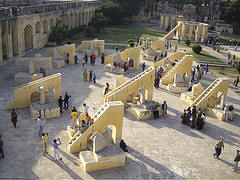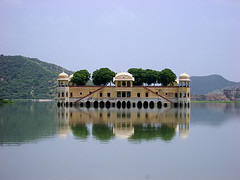|
Famous as Pink City- Jaipur is
certainly a major attraction for first time visitor. The city is surrounded on
all sides by rugged hills and symbolizes the nine divisions of the universe. The
city, apart from offering innumerable historical monuments, palaces and forts
patronizes several arts too. Fascinating places worth a visit include: Amer
Palace, City Palace, Hawa Mahal, Nahargarh and Jai Garh.
Jaipur, the city-capital in the tone of an autumnal sunset, literally lush pink
when prince Albert, the consort of Queen Victoria, stepped on its soil in 1883.
Interspersing the play of red and pink were white borders and motifs,
painstakingly outlining the architectural highlights of Jaipur's buildings.
Jaipur had been like that since 1727 when Maharaja Sawai Jai Singh II had it
built that year.
Interestingly, the royal family's earlier residence at Amber, was only 11 km
away and had been since the 10th century. Seven hundred years later, the
Maharaja chose to raise a 'City of Victory, and aptly baptised it Jaipur.
Coincidentally, the name also incorporated the first name of the Maharaja thus
immortalising the builder : both through his nomenclature of dynasty and concept
of ideals.
Jaipur was and remains the only city in the world symbolizing the nine divisions
of the Universe through nine rectangular sectors subdividing it. A young Bengali
architect Vidyadhar Bhattacharya, formalised the city's plans on the 'Shipa
Shastra', the epochal Hindu treatise on architecture, tempering it with
sublimity of Mughal and Jain influences of the times. The Palaces and forts of
the yesteryears that were witness to royal processions and splendour are now
living monuments. There is a timeless quality to Jaipur's bazaars and of
eternity to its people. Could the woman drying chillies under the sun, in the
shadow of the fort, have been there a hundred years ago? Could not the Jeweller,
so carefully crafting the gold and precious stones of his trade, be equally its
vision of the future.
Jaipur is a great city and this is its most noticeable aspect. Buildings testify
to it. Its Palaces, luxury hotels, ancient beautifully carved and painted
Havelies pay homage to the grand capital of princes and kings, a city of the
past that belongs to India's future.
PLACES TO SEE
Hawa Mahal
Located at Sierh Deori bazar, Hawa Mahal, literally the Pala e of Winds, built
in 1799 by Maharaja Sawai Pratap Singh, displays fanciful architecture and is a
remarkable landmark of Jaipur. So named because the palace has specially
latticed screens and arches for an unbridled flow of the air currents but is a
set pattern with the passage of the sun. Till the recent past, ladies of the
court from within the palace positioned themselves by the balconies to watch
processions passing through in the streets below without themselves being
observed by the people. e of Winds, built
in 1799 by Maharaja Sawai Pratap Singh, displays fanciful architecture and is a
remarkable landmark of Jaipur. So named because the palace has specially
latticed screens and arches for an unbridled flow of the air currents but is a
set pattern with the passage of the sun. Till the recent past, ladies of the
court from within the palace positioned themselves by the balconies to watch
processions passing through in the streets below without themselves being
observed by the people.
Amer Fort
In earlier times, the entire complex was owned by the Minas and dedicated to 'Amba
Mata', the incarnation of earth and fertility. Amber overlooks the Moata Lake
and is rated as a marvel of bastion excelling in architectural and building
skills. Amber had the distinction of being the capital for six long centuries
before Jaipur came into being. A fascinating blend of Hindu and Muslim
influences is distinctly discernible in its architecture. Amongst the most
majestic of apartments is Jai Mandir or the Hall of Victory. The palace complex
also boats of a Hall of Mirrors, the like of which is not seen in the country
elsewhere. Sukh Niwas, the Hall of Pleasure, is a marvel of 17th century
engineering, its best feat being a unique system of 'air-conditioning'. The
model operandi was based on a cool breeze blowing through a fall of cascading
waters. To ascend the fort, jeeps and elephants can be hired near the entrance
gate.
Jantar Mantar
Emperor Sawai Jai Singh II, the builder of the city has
 to his credit five
observatories in different parts of the country. The one he raised at Jaipur is
the largest and best preserved. Huge instruments in intricate masonry offer an
accurate measurement of the time, the declination of the sun, the altitude and
the azimuth, the position of constellations in the sky for the day, the eclipses
and the allied astronomical phenomena. to his credit five
observatories in different parts of the country. The one he raised at Jaipur is
the largest and best preserved. Huge instruments in intricate masonry offer an
accurate measurement of the time, the declination of the sun, the altitude and
the azimuth, the position of constellations in the sky for the day, the eclipses
and the allied astronomical phenomena.
City Palace
This former royal residence is an imposing blend of traditional Rajasthani and
Mughal architecture and the craftmanship. Surrounded by crenellated walls this
piece-de-resistance of Jaipur's palaces occupies one seventh of the walled city,
comprising a string of minor palaces and imposing halls, Of special significance
is the 'Chandra Mahal' which overlooks the breathtaking Jai Niwas Gardens and
the highly revered Shri Gobind Dev Temple. The Museum within the palace has an
array of galleries of rare paintings, exquisite miniatures, scholarly
manuscripts, artefacts and traditional treatises on architecture. The fine
collection of guns and swords on display dates back to the 15th century and is
one of the best in India. the 15th century and is
one of the best in India.
Jal Mahal
As its name denotes, this is a palace built amidst a lake and intended as the
summer resort for the royal family. The palace is noted for its intricate
architecture.
Nahargarh Fort
13 km, a picturesque road winds its way up the hills. At one time, the fort was
a retreat for the royal family. Nahargarh Fort commands a panoramic view from
the top of the hill. |